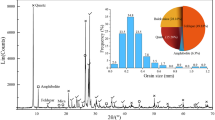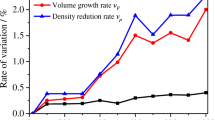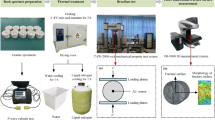Abstract
High temperature can damage rocks and change their mechanical properties. In this study, some basic and vital properties of granite heated at different temperatures were investigated. Combined with previous research results, the effect of temperature on some physical and mechanical parameters of granite and the relationships among P-wave velocity (vp), tensile strength (σt), and mode-I fracture toughness (KIC) were analyzed. The results showed that the mass, vp, and σt of granite decreased gradually with increasing heat-treatment temperature. The KIC increased slightly from room temperature (20 °C) to 100 °C and decreased gradually when it exceeded 100 °C. The ratio α of σt to KIC increased with increasing temperature; α is related to brittleness of the rock and it can be used as index for measuring its brittleness. The vp of granite had a strong linear relationship with the mechanical properties. The two damage factors based on vp can characterize well the degradation of the mechanical properties of granite below 400 and above 400 °C. The results provide an important guide for evaluating the damage degree of high temperature on rocks using the ultrasonic non-destructive testing technology and characterizing quantitatively the ductility and brittleness of rocks.













Similar content being viewed by others
References
Alm, O., Jaktlund, L. L., & Shaoquan, K. (1985). The influence of microcrack density on the elastic and fracture mechanical properties of Stripa granite. Physics of the Earth and Planetary Interiors, 40(3), 161–179.
Bhutto, A. W., Bazmi, A. A., & Zahedi, G. (2013). Underground coal gasification: From fundamentals to applications. Progress in Energy and Combustion Science, 39(1), 189–214.
Bieniawski, Z. T., & Hawkes, I. (1978). Suggested methods for determining tensile strength of rock materials. International Journal of Rock Mechanics and Mining Sciences & Geomechanics Abstracts, 15, 99–103.
Chaki, S., Takarli, M., & Agbodjan, W. P. (2008). Influence of thermal damage on physical properties of a granite rock: Porosity, permeability and ultrasonic wave evolutions. Construction and Building Materials, 22(7), 1456–1461.
Chen, L., Wang, C. P., Liu, J. F., Li, Y., Liu, J., & Wang, J. (2017). Effects of temperature and stress on the time-dependent behavior of Beishan granite. International Journal of Rock Mechanics and Mining Sciences, 93, 316–323.
Çobanoǧlu, I., & Çelik, S. B. (2008). Estimation of uniaxial compressive strength from point load strength, schmidt hardness and P-wave velocity. Bulletin of Engineering Geology and the Environment, 67(4), 491–498.
De Bresser, J. H. P., Urai, J. L., & Olgaard, D. L. (2005). Effect of water on the strength and microstructure of Carrara marble axially compressed at high temperature. Journal of Structural Geology, 27(2), 265–281.
Fan, L. F., Wu, Z. J., Wan, Z., & Gao, J. W. (2017). Experimental investigation of thermal effects on dynamic behavior of granite. Applied Thermal Engineering, 125, 94–103.
Feng, G., Kang, Y., Meng, T., Hu, Y. Q., & Li, X. H. (2017). The Influence of temperature on mode I fracture toughness and fracture characteristics of sandstone. Rock Mechanics and Rock Engineering, 50, 2007–2019.
Feng, G., Wang, X. C., Kang, Y., Luo, S. G., & Hu, Y. Q. (2019). Effects of temperature on the relationship between Mode-I fracture toughness and tensile strength of rock. Applied Sciences. https://doi.org/10.3390/app9071326
Fowell, R. J., Hudson, J. A., Xu, C., Chen, J. F., & Zhao, X. (1995). ISRM commission on testing methods: Suggested method for determining mode I fracture toughness using cracked chevron notched Brazilian disc (CCNBD) specimens. International Journal of Rock Mechanics and Mining Sciences & Geomechanics Abstracts, 32(1), 57–64.
Glover, P. W. J., Baud, P., Darot, M., Meredith, P. G., Boon, S. A., LeRavalec, M., et al. (1995). α/β phase transition in Quartz Monitored using acoustic emissions. Geophysical Journal International, 120(3), 775–782.
Griffiths, L., Heap, M. J., Baud, P., & Schmittbuhl, J. (2017). Quantification of microcrack characteristics and implications for stiffness and strength of granite. International Journal of Rock Mechanics and Mining Sciences, 100, 138–150.
Gunsallus, K. L., & Kulhawy, F. H. (1984). A comparative evaluation of rock strength measures. International Journal of Rock Mechanics and Mining Sciences and, 21(5), 233–248.
Guo, Q., Su, H., Liu, J., Yin, Q., Jing, H., & Yu, L. (2020). An experimental study on the fracture behaviors of marble specimens subjected to high temperature treatment. Engineering Fracture Mechanics, 225, 106862.
Haberfield, C. M., Johnston, I. W. (1989) Relationship between fracture toughness and tensile strength for geomaterials. In Proceedings of 12th international conference of soil mechanics and foundation engineering, SMFE Rio De Janeiro, Brazi pp. 47–52.
Hajpál, M., & Török, Á. (2004). Mineralogical and colour changes of quartz sandstones by heat. Environmental Geology, 46(3–4), 311–322.
Harison, J. A., Hardin, B. O., & Mahboub, K. (1994). Fracture toughness of compacted cohesive soils using ring test. Journal of Geotechnical Engineering ASCE, 120(5), 872–891.
Jamshidi, A., Zamanian, H., & Zarei Sahamieh, R. (2018). The effect of density and porosity on the correlation between uniaxial compressive strength and P-wave velocity. Rock Mechanics and Rock Engineering, 51(4), 1279–1286.
Jin, P., Hu, Y., Shao, J., Zhao, G., Zhu, X., & Li, C. (2018). Experimental study on physico-mechanical and transport properties of granite subjected to rapid cooling. Chinese Journal of Rock Mechanics and Engineering, 37, 2556–2564.
Jin, P., Hu, Y., Shao, J., Zhao, G., Zhu, X., & Li, C. (2019). Influence of different thermal cycling treatments on the physical, mechanical and transport properties of granite. Geothermics, 78, 118–128. https://doi.org/10.1016/j.geothermics.2018.12.008
Kahraman, S., & Altindag, R. (2004). A brittleness index to estimate fracture toughness. International Journal of Rock Mechanics and Mining Sciences, 41(2), 343–348.
Keshavarz, M., Pellet, F. L., & Loret, B. (2010). Damage and changes in mechanical properties of a gabbro thermally loaded up to 1000 °C. Pure and Applied Geophysics, 167(12), 1511–1523.
Kılıç, A., & Teymen, A. (2008). Determination of mechanical properties of rocks using simple methods. Bulletin of Engineering Geology and the Environment, 67(2), 237–244.
Kuruppu, M. D., Obara, Y., Ayatollahi, M. R., Chong, K. P., & Funatsu, T. (2014). ISRM-suggested method for determining the Mode I static fracture toughness using semi-circular bend specimen, 2007–2014. Doi: https://doi.org/10.1007/978-3-319-07713-0
Lakshmikantha, M. R., Prat, P. C., & Ledesma, A. (2008). Discussion on “experimental study on fracture toughness and tensile strength of a clay” [engineering geology 94 (2007) 64–75]. Engineering Geology, 101(3–4), 295–296.
Li, C., Hu, Y., Meng, T., Zhang, C., Gao, R., Jin, P., & Hu, Y. (2020). Mode-I fracture toughness and mechanisms of Salt-Rock gypsum interlayers under real-time high-temperature conditions. Engineering Fracture Mechanics, 240, 107357.
Martinho, E., Mendes, M., & Dionísio, A. (2017). 3D imaging of P-waves velocity as a tool for evaluation of heat induced limestone decay. Construction and Building Materials, 135, 119–128.
Miao, S., Pan, P. Z., Zhao, X., Shao, C., & Yu, P. (2021). Experimental study on damage and fracture characteristics of Beishan granite subjected to high-temperature treatment with DIC and AE techniques. Rock Mechanics and Rock Engineering, 54(2), 721–743.
Ouchterlony, F. (1988). Suggested methods for determining the fracture toughness of rock. International Journal of Rock Mechanics and Mining Sciences & Geomechanics Abstracts, 25(2), 71–96.
Ozguven, A., & Ozcelik, Y. (2014). Effects of high temperature on physico-mechanical properties of Turkish natural building stones. Engineering Geology, 183, 127–136.
Peng, J., Rong, G., Cai, M., Yao, M. D., & Zhou, C. B. (2016). Physical and mechanical behaviors of a thermal-damaged coarse marble under uniaxial compression. Engineering Geology, 200, 88–93.
Qin, Y., Tian, H., Xu, N. X., & Chen, Y. (2020). Physical and mechanical properties of granite after high-temperature treatment. Rock Mechanics and Rock Engineering, 53(1), 305–322. https://doi.org/10.1007/s00603-019-01919-0
Sha, S., Rong, G., Tan, J., He, R., & Li, B. (2020). Tensile strength and brittleness of sandstone and granite after high-temperature treatment: A review. Arabian Journal of Geosciences, 13(14), 1–13.
Shao, S., Ranjith, P. G., Wasantha, P. L. P., & Chen, B. K. (2015). Experimental and numerical studies on the mechanical behaviour of Australian Strathbogie granite at high temperatures: An application to geothermal energy. Geothermics, 54, 96–108.
Sun, H., Sun, Q., Deng, W., Zhang, W., & Lü, C. (2017). Temperature effect on microstructure and P-wave propagation in Linyi sandstone. Applied Thermal Engineering, 115, 913–922.
Sun, Q., Zhang, W., Xue, L., Zhang, Z., & Su, T. (2015). Thermal damage pattern and thresholds of granite. Environmental Earth Sciences, 74(3), 2341–2349.
Sun, Q., Zhang, Z., Xue, L., & Zhu, S. (2013). Physico-mechanical properties variation of rock with phase transformation under high temperature. Chinese Journal of Rock Mechanics and Engineering, 32(5), 935–942.
Tian, H., Kempka, T., Xu, N. X., & Ziegler, M. (2012). Physical properties of sandstones after high temperature treatment. Rock Mechanics and Rock Engineering, 45(6), 1113–1117.
Tian, H., Kempka, T., Yu, S., & Ziegler, M. (2016). Mechanical properties of sandstones exposed to high temperature. Rock Mechanics and Rock Engineering, 49(1), 321–327.
Tian, H., Zhu, Z., Ranjith, P. G., Jiang, G., & Dou, B. (2021). Experimental Investigation of drillability indices of thermal granite after water-cooling treatment. Natural Resources Research. https://doi.org/10.1007/s11053-021-09926-1
Vavro, L., & Souček, K. (2013). Study of the effect of moisture content and bending rate on the fracture toughness of rocks. Acta Geodynamica et Geomaterialia, 10, 247–253.
Vázquez, P., Shushakova, V., & Gómez-heras, M. (2015). Influence of mineralogy on granite decay induced by temperature increase: Experimental observations and stress simulation. Engineering Geology, 189, 58–67.
Wang, G. D. (2003) Experiment research on the effects of temperature and viscoelastoplastic analysis of Beishan Granite; Xi’an Institute of Science and Technology: Xi’an, China.
Wang, D., Bian, X., Qin, H., Sun, D., & Yu, B. (2021a). Experimental investigation of mechanical properties and failure Behavior of fluid-saturated hot dry rocks. Natural Resources Research, 30(1), 289–305.
Wang, D., Zhou, F., Dong, Y., Sun, D., & Yu, B. (2021b). Experimental investigation of thermal effect on fracability index of geothermal reservoirs. Natural Resources Research, 30(1), 273–288.
Wang, J. J., Zhu, J. G., Chiu, C. F., & Zhang, H. (2007). Experimental study on fracture toughness and tensile strength of a clay. Engineering Geology, 94(1–2), 65–75.
Wang, P., Xu, J. Y., Liu, S., Chen, T. F., & Fang, X. Y. (2014). Analysis of high temperature damage and modulus of sandstone. Rock and Soil Mechanics, 35, 211–216.
Wei, S., Yang, Y., Xu, C., Wang, M., Shen, W., & Su, C. (2021). Experimental study on physical and mechanical properties of gypsum rock during high-temperature dehydration-hydration expansion. Natural Resources Research, 30(2), 1121–1140.
Wu, Y., Li, X. Z., Huang, Z., & Xue, S. (2021). Effect of temperature on physical, mechanical and acoustic emission properties of Beishan granite, Gansu Province China. Natural Hazards, 107(2), 1577–1592.
Yang, S. Q., Ranjith, P. G., Jing, H., Tian, W., & Ju, Y. (2017). An experimental investigation on thermal damage and failure mechanical behavior of granite after exposure to different high temperature treatments. Geothermics, 65, 180–197.
Yang, S. Q., Tian, W. L., & Dong, J. P. (2021a). Experimental study on failure mechanical properties of granite with two grain sizes after thermal treatment. Chinese Journal of Geotechnical Engineering, 43(2), 281–289.
Yang, S. Q., Yang, D., & Kang, Z. (2021b). Experimental investigation of the anisotropic evolution of tensile strength of oil shale under real-time high-temperature conditions. Natural Resources Research, 30(3), 2513–2528.
Zhang, L., Mao, X., Liu, R., Li, Y., & Yin, H. (2014). Meso-structure and fracture mechanism of mudstone at high temperature. International Journal of Mining Science and Technology, 24(4), 433–439.
Zhang, W. Q., Sun, Q., Hao, S., Geng, J., & Lv, C. (2016b). Experimental study on the variation of physical and mechanical properties of rock after high temperature treatment. Applied Thermal Engineering, 98, 1297–1304. https://doi.org/10.1016/j.applthermaleng.2016.01.010/
Zhang, W. Q., Sun, Q., Hao, S., & Wang, B. (2016a). Experimental study on the thermal damage characteristics of Limestone and underlying mechanism. Rock Mechanics and Rock Engineering, 49(8), 2999–3008.
Zhang, W. Q., Sun, Q., Zhang, Y., Xue, L., & Kong, F. (2018). Porosity and wave velocity evolution of granite after high-temperature treatment: A review. Environmental Earth Sciences, 77(9), 1–13.
Zhang, Y., Sun, Q., Cao, L., & Geng, J. (2017). Pore, mechanics and acoustic emission characteristics of limestone under the influence of temperature. Applied Thermal Engineering, 123, 1237–1244.
Zhang, Z. X. (2002). An empirical relation between mode I fracture toughness and the tensile strength of rock. International Journal of Rock Mechanics and Mining Sciences, 39(3), 401–406.
Zhi, L., Xu, J., Liu, Z., Liu, S., & Chen, T. (2012). Research on ultrasonic characteristics and Brazilian splitting-tensile test of granite under post-high temperature. Rock and Soil Mechanics, 33, 61–66.
Zhu, S., Zhang, W., Sun, Q., Deng, S., Geng, J., & Li, C. (2017). Thermally induced variation of primary wave velocity in granite from Yantai: Experimental and modeling results. International Journal of Thermal Sciences, 114, 320–326.
Zhu, Z. N., Tian, H., Jiang, G. S., & Cheng, W. (2018). Effects of high temperature on the mechanical properties of chinese marble. Rock Mechanics and Rock Engineering, 51(6), 1937–1942.
Zhu, Z. N., Tian, H., Kempka, T., Jiang, G., Dou, B., & Mei, G. (2021). Mechanical behaviors of granite after thermal treatment under loading and unloading conditions. Natural Resources Research, 30(3), 2733–2752.
Zuo, J. P., Wang, J. T., Sun, Y. J., Chen, Y., Jiang, G. H., & Li, Y. H. (2017). Effects of thermal treatment on fracture characteristics of granite from Beishan, a possible high-level radioactive waste disposal site in China. Engineering Fracture Mechanics, 182, 425–437.
Acknowledgments
This work was funded by the National Natural Science Foundation of China (Grant Nos. 41807195, and 51974191) and Graduate Innovative Projects of Shanxi Province (No. RC2000003602).
Author information
Authors and Affiliations
Corresponding author
Rights and permissions
About this article
Cite this article
Hu, Y., Hu, Y., Zhao, G. et al. Experimental Investigation of the Relationships Among P-Wave Velocity, Tensile Strength, and Mode-I Fracture Toughness of Granite After High-Temperature Treatment. Nat Resour Res 31, 801–816 (2022). https://doi.org/10.1007/s11053-022-10020-3
Received:
Accepted:
Published:
Issue Date:
DOI: https://doi.org/10.1007/s11053-022-10020-3




